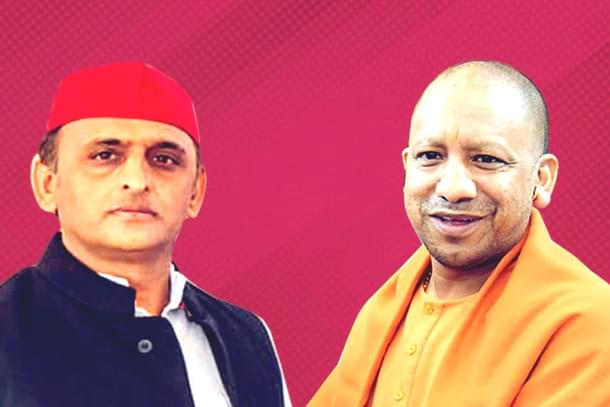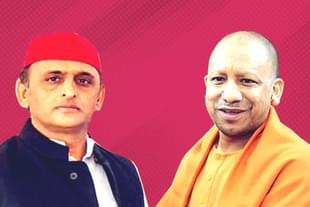Commentary
In Maps: Why Uttar Pradesh 2022 Will Very Likely Be A Bipolar Affair
Venu Gopal Narayanan
Dec 18, 2021, 11:40 AM | Updated 11:39 AM IST
Save & read from anywhere!
Bookmark stories for easy access on any device or the Swarajya app.


This is the first part of a series of articles, which will analyze the forthcoming assembly elections in Uttar Pradesh using historical voter data and ongoing opinion polls.
A stock constraint with analyzing the electoral data of Uttar Pradesh is a tendency for political alliances to shift rather dramatically from election to election. Ever since the Congress monolith disintegrated in the 1980s, almost everyone has allied at some point of time or the other, with everyone else, except the Congress with the Bharatiya Janata Party (BJP).
The BJP has gone with Mulayam Singh Yadav’s Samajwadi Party (SP), in the latter’s earlier avatar of VP Singh’s short-lived Janata Dal. The SP has gone with Mayawati’s Bahujan Samaj party (BSP) more than once, in spite of both having subverted official machinery to try and sink the other fairly viciously. And on some occasions, there have been tacit understandings even if formal alliances weren’t announced.
This political fickleness is further compounded by the waxing and waning of various political parties – large and small. The Rashtriya Lok Dal (RLD), which once ruled the roost, is now a pale shadow. At the same time, smaller outfits like the Apna Dal (AD), or the Nishad and Rajbhar parties, have performed well in their restricted pockets, along with larger parties.
To top that, the BJP is judged to be presently following a strong growth path once again, after a long gap of two decades, even as the SP seems to be re-consolidating its vote base to a lesser extent, after receiving two harrowing wallopings from the electorate in quick succession.
How, in the midst of this confusing whirl, might number-crunchers identify those neat trend shifts they need, to make forecasts with, when there is no continuum or state-wide benchmark on which to peg voting patterns? As a result, it is almost impossible to conduct apples-to-apples comparisons of votes and swings between two elections, or to derive historical trends.
A brief survey of the immediate past, in the build up to the 2022 assembly elections, shows just how frustratingly this phenomenon has bedeviled the psephology of Uttar Pradesh. (Of course, from a broader perspective, this confusion actually represents one stage of a generational socio-political churning which commenced in the 1980s; it is yet to run its course, and will be addressed towards the end of the series).
In the 2017 assembly elections, the Congress allied with the SP, while the BSP and the RLD went it alone. All were essentially wiped out, except the SP to some extent, as the BJP tied up with the AD and a Rajbhar party in a few selected seats, to sweep the state like never before. The BJP’s vote share rose from 15 to 40 per cent, and their tally of seats in a house of 403 went from 47 to 312.
In the 2019 general elections, the Congress decided to go it alone, and the Rajbhar party left the BJP, while the SP, the BSP and the RLD came together. And yet, the result was largely the same – a BJP sweep; their alliance won 284 assembly segments, and their vote share rose even further to a resolute 51 per cent.
Consequently, Swarajya has had to apply both novel, and lesser-used, analytical tools, to try and reduce the prevailing swirl to a more tangible, more representative, picture.
The first tool is a comparative tabulation of vote shares in seats, won by tranche, i.e., how many seats a particular alliance won for a given vote share segment. The results of the 2017 assembly seats have been compared with those of the 2019 general elections, at the assembly segment level. This selection was done for three reasons.
First, the BJP’s vote share has been rising consistently and considerably in the state since 2012, when it was a meager 15 per cent, so ignoring the 2019 data point would have meant underestimating outcomes by an unacceptable margin.
Second, the 2019 data needs to be incorporated, if the consolidations taking place since 2017 under an SP umbrella, irrespective of its shifting alliances, are to be satisfactorily captured by analyses.
Third, comparing assembly seats of 2017 to assembly segments of 2019, rather than abruptly leaping to poll surveys of 2021 while skipping key trend shifts, allows contiguity of analysis to be maintained. In essence, this table offers as close an apples-to-apples comparison for this sort of analysis, as may be meaningfully derived under UP’s fluid political dynamics.

Such a tabulation clearly shows that the contest in UP became a predominantly two-way affair in 2019. In 2017, the BJP and its allies won 84 of their 325 seats, or over a quarter, with less than 40 per cent of the popular vote. But in 2019, it didn’t win a single segment in this tranche.
Similarly, while the SP and Congress won 28 of 54 seats in 2017 with less than 40 per cent vote share (over half of their total), the SP alliance in 2019 (minus Congress; plus BSP and RLD) won only one.
Two charts depict this shift in voting patterns for the BJP and the SP separately:


See how the BJP’s alliance vote shares consolidate from 2017 to 2019 in two maps below:


Also see how the SP’s vote share consolidation follows the same trend from 2017 to 2019 in two more maps below:


This tightening up of the contest is reflected in the total vote share of the two principal groupings in the elections. In 2017, the aggregate vote share of the BJP and SP groups was just 69.5 per cent, meaning that the balance vote was split amongst more than a quarter of the electorate (primarily the BSP). The required winning margin was therefore well below the halfway mark.
But in 2019, the total of the two groups went up to 90.4 per cent. The necessary margin of victory too, went up in step, with third parties like the Congress and independents being squeezed to a wafer. We see that the SP group won over 60 per cent of their segments in 2019 with over 50 per cent of the vote share (66 of 109), while the BJP won 80 per cent of their segments in this tranche (227 of 284).
This development reflects social consolidations and counter-consolidations by voters in UP (to be elaborated upon in a subsequent piece), which appear to be rising above shifting alliances into primarily two-way affairs.
Therefore, Swarajya’s current assessment is that this trend will continue into the 2022 assembly elections, with the BJP and the SP forming the two main poles.
The implications are significant:
One, in that case, any party not allied with one of the two main groups is going to get severely squeezed. As things stand, that axe looks set to fall on the BSP, and what’s left of the Congress.
Two, the BJP’s vote share will therefore be higher than what it was in 2017. This logic brings into question a series of opinion polls between September and December 2021, in which pollsters have doggedly predicted the BJP to stay stuck at 41 per cent of the popular vote.
And, three, the key metric will then be the vote differential between the SP and BJP alliances. This, allied with a partial splitting of the vote, in those pockets where the BSP is able to hold on to its core Jatav vote (if it can), means that a decisive advantage will continue to rest with the BJP in the forthcoming elections.
In the next piece of this series, our focus will be on wins by reservation category, and how those results motivate the forging or breaking of political alliances in Uttar Pradesh.
All electoral data from ECI website.
Venu Gopal Narayanan is an independent upstream petroleum consultant who focuses on energy, geopolitics, current affairs and electoral arithmetic. He tweets at @ideorogue.





